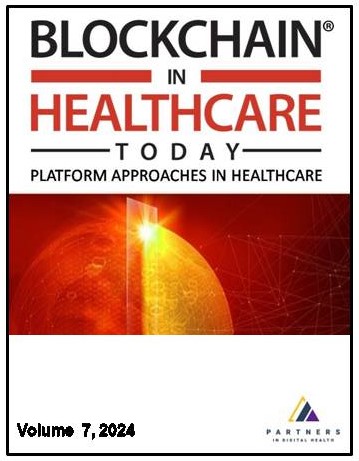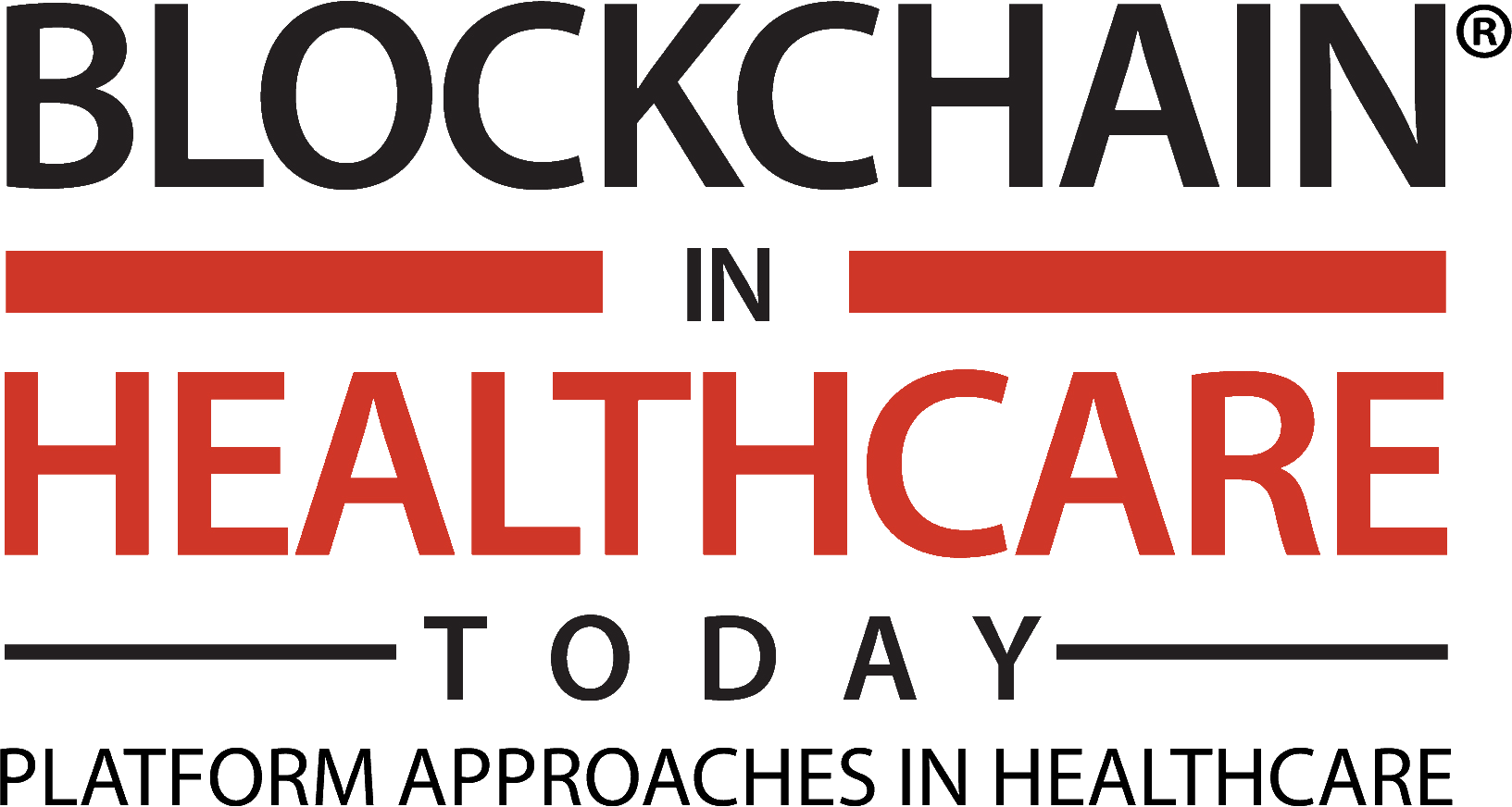Current issue

Volume 7, Issue 3, 2024
Online ISSN: 2573-8240
Volume 7 , Issue 3, (2024)
Published: 16.12.2024.
Open Access
Blockchain in Healthcare Today (BHTY) is the leading international open access journal that amplifies and disseminates platform approaches in healthcare and distributed ledger technology research and innovations. Fields of interest include healthcare information systems, leveraging data science tools and techniques, interoperability, consent mechanisms, privacy preservation, security of health data, clinical trials management, supply chain management, revenue cycle automation, immersive technologies, tokenomics, governance, regulation, network technologies, clinical computing, cryptography, and failed experiments in this expanding specialty field of research.
All issues
Contents
04.01.2019.
Use Cases
Evaluating Blockchain for the Governance of the Plasma Derivatives Supply Chain: How Distributed Ledger Technology Can Mitigate Plasma Supply Chain Risks
Objective: This exploratory study examines how distributed ledger technologies could be used within the plasma derivatives supply chain. The plasma derivatives are used increasingly in the pharmaceutical market and the supply chain is global. However, there are significant risks relating to the governance of the supply. The risks include unclear origin of plasma and the propagation of contaminated or poor-quality blood to the pharmaceutical production process. From an ethical perspective, the risk is that vulnerable individuals are exploited in the donation process. Finally, the plasma supply chain currently depends on only a few exporters of plasma, which presents a supply chain risk. Design: The blockchain technology is piloted in other areas of pharmaceutical supply chains and in this study we examine those solutions and conceptualize how a similar solution can be applied to the plasma supply chain. We identify risks within the plasma supply chain and discuss how blockchain-based solutions can mitigate those risks. Results: Drawing on existing literature within the pharmaceutical blockchain arena, we introduce a solution to verify the origin of plasma. We also model how the blockchain technology can be used to tackle ethical and supply chain risks. Conclusions: Blockchain can have a role in mitigating plasma supply chain risks. The area is, however, novel and requires more research.
Teijo Peltoniemi, Jarkko Ihalainen
04.01.2019.
Methodology
Ethical Implementation of the Learning Healthcare System with Blockchain Technology
We propose that blockchain technology complemented by secure computation methods can foster implementation of a learning healthcare system (LHCS) by minimizing upfront patient-facing compromises with unsurpassed data security and privacy, and by optimizing the system’s fulfillment of its obligations to respect patients through transparency, engagement, and accountability. We demonstrate how a blockchain-enabled LHCS could foster patient willingness to contribute to learning by providing desired security and control over health data. In addition, secure computation methods could enable meta-analysis without exposing individual-level data, thus allowing the system to protect patients’ privacy while simultaneously learning from their data. The transparency and immutability of blockchain ledgers would also support the public’s trust in the system by allowing patients to audit and oversee which of their data are used, how they are used, and by whom. Furthermore, blockchain communities are community-governed peer-to-peer networks in which sharing builds mutually beneficial value, offering a model for engaging patients as LHCS stakeholders. Smart contracts could be used to ensure accountability of the system by embedding feedback mechanisms by which patients directly and automatically realize benefits of sharing their data.
Marielle S. Gross, Robert C. Miller
04.01.2019.
Letters to the Editor
Response to Zolfaghari et al.
Please see the related Research Article (DOI: https://doi.org/10.30953/bhty.v2.38) and the related Letter to the Editor (DOI: https://doi.org/10.30953/bhty.v2.98)
You Chen
04.01.2019.
Narrative/Systematic Review/Meta-Analysis
Toward Application of Blockchain for Improved Health Records Management and Patient Care
Technological advancements have proven to be indispensable for improving patient care, yet they continue to present a host of problems. One of the most pressing concerns is how to improve quality of care while controlling costs. Beyond clinical care, one plausible solution is to share patient information freely and efficiently. Hospitals and clinics may share data internally, but external information sharing remains an issue. Despite the digitization of medical records, there remains a lack of adequate computing infrastructure or unwillingness to share data among providers. Care quality often suffers as a result. Implementing a type of peer-to-peer distributed digital technology, known as a blockchain, to record and transmit transactional data could be a solution to these concerns. Originally, blockchain was developed to record cryptocurrency transactions. However, as blockchain technologies have matured and adopted across dissimilar industries, the feasibility of possible applications of blockchain technology in healthcare is getting more attention. This article explores possible opportunities of adoption of blockchain technology to improve patient data security, privacy, and care while outlining the challenges that practitioners may encounter.
Gracie Carter, Denise White, Anusha Nalla, Hossain Shahriar, Sweta Sneha
04.01.2019.
Use Cases
DMMS: A Decentralized Blockchain Ledger for the Management of Medication Histories
Background: Access to accurate and complete medication histories across healthcare institutions enables effective patient care. Histories across healthcare institutions currently rely on centralized systems for sharing medication data. However, there is a lack of efficient mechanisms to ensure that medication histories transferred from one institution to another are accurate, secure, and trustworthy.
Methods: In this article, we introduce a decentralized medication management system (DMMS) that leverages the advantages of blockchain to manage medication histories. DMMS is realized as a decentralized network under the hyperledger fabric framework. Based on the network, we designed an architecture, within which each prescriber can create prescriptions for each patient and perform queries about historical prescriptions accordingly. Finally, we analyzed the advantages of DMMS over centralized systems in terms of accuracy, security, trustworthiness, and privacy.
Results: We developed a proof of concept to showcase DMMS. In this system, a prescriber prescribes medications for a patient and then encrypts the prescriptions via the patient’s public keys. Patients can query their own prescriptions from different histories across healthcare institutions and then decrypt the prescriptions via their private keys. At the same time, a prescriber can query a patient’s prescription records across healthcare institutions after approval from the patient. Analytic results show that DMMS can improve security, trustworthiness, and privacy in medication history sharing and exchanging across healthcare institutions. In addition, we discuss the potential for DMMS in e-prescribing markets. Conclusions: This study shows that a distributed secure ledger can enable reliable, interoperable, and accurate medication history sharing.
Patrick Li, Scott D. Nelson, Bradley A. Malin, You Chen
03.12.2019.
Conference Presentations
Medical Moon Shots and Space...The Final Frontier
Pierre-Alexandre Fournier, Jin Wei-Kocsis, Ray Dogum
03.12.2019.
Conference Presentations
Blockchain-enabled Seamless Safe Notification Services
Vince Albanese
04.01.2019.
Opinions/Perspectives/Point of View
Top 10 Blockchain Predictions for the (Near) Future of Healthcare
To review blockchain lessons learned in 2018 and near-future predictions for blockchain in healthcare, Blockchain in Healthcare Today (BHTY) asked the world's blockchain in healthcare experts to share their insights. Here, our internationally-renowned BHTY peer-review board discusses their major predictions.Based on their responses, presented in detail below, ten major themes (Table ) for the future of blockchain in healthcare will emerge over the 12 months. CORRIGENDUM: This following paragraph has been corrected (page 3, first paragraph) from: "Fourth, with over 1000 insurance companies in the country, filling out paperwork to documentprovider training and licensure is a nightmare. The Synaptic Health Alliance aims to simplifythis process by putting all credentialing information on a distributed public ledger for all stakeholders to access.1" To: "Fourth, keeping health care provider directories maintained by health plans up-to-date is a critical, complex issue facing organizations across the health care system. The first project of the Synaptic Health Alliance aims to simplify this process by putting provider demographic information on a permissioned blockchain for Alliance members to access and maintain.1"
John D Halamka, Gil Alterovitz, William J. Buchanan, Tory Cenaj, Kevin A. Clauson, Vikram Dhillon, Florence D. Hudson, Manouchehr (Mitch) Mokhtari, Dennis A. Porto, Ana Rutschman, Anh L. Ngo
04.01.2019.
Use Cases
Implementation Considerations for Blockchain in Healthcare Institutions
Objective: This article aims to provide a primer on blockchain technology and implementation considerations for blockchain at healthcare institutions.
Results: After research and interviews, we developed a primer and a high-level implementation guide for healthcare systems exploring the use of blockchain technology.
Conclusions: The use of blockchain technology in health care is at a promising stage in development but blockchain-based applications are yet to be demonstrated as a viable platform for exchanging and reviewing information. Healthcare systems should be cautiously optimistic regarding the potential of blockchain and do a thorough business and technical diligence that is driven by targeted use cases to be successful.
Ketan Paranjape, Mitchell Parker, David Houlding, Josip Car
04.01.2019.
Technical Briefs & Reports
Voice Biometrics and Blockchain: Secure Interoperable Data Exchange for Healthcare
PURPOSE
The healthcare system in the United States is unique. From payor to provider, patients have many choices but they lack in the ability to manage or share their health information. This complicated care paradigm places patients at a distinct disadvantage. Legislation clearly defines government expectations of data availability but not how to achieve exchange. Because methods of sharing are left to the discretion of care providers and software vendors, non-interoperability is the standard.
METHODS
The OpenPharma Blockchain on Fast Healthcare Interoperability Resources (FHIR) (OBF) solution is interoperable by design. OBF empowers patients with data access through biometric identity authentication, blockchain, and machine-–to-machine secure data access. OBF provides authenticated users read-only, real-time access to patient records using the healthcare interoperability standard HL7 FHIR. OBF is built around a modern, browser-based user interface, blockchain technologies (leveraging either Ethereum or the Hedera protocols) and modular, modern software exposed as Application Programming Interfaces (APIs). This allows OBF to meet the Office of National Coordinator for Health Information (ONC) metrics, which include sending, receiving, and finding information from outside sources and using that information to make informed clinical decisions without additional burden on clinicians or patients.
RESULTS
Building on the HL7 FHIR application community practices, OBF is a SMART-on-FHIR plug-in for Electronic Medical Record (EMR) systems. Using OBF, patients can identify themselves and gain access to their medical records using their voice. This unique feature is accomplished through the Saavha voice print biometrics technology. Saavha returns a unique member ID that is passed directly to the OBF blockchain smart contract for storage and interoperable patient record access (the ID does not contain public health information [PHI]).
To ensure complete privacy, all information is passed through multiple layers of encryption where no keys are stored locally. Additionally, no PHI is shared to the blockchain. To ensure privacy, OBF creates a new encrypted address for the FHIR patient record object, using the Saavha generated member ID as the unique identifier. This encrypted address is then published on chain, making it available to participating providers. Providers must register their relationships to patients before OBF will permit online viewing of patient records. Patient record access is accomplished through voice verification and real-time surfacing of encrypted patient data through the OBF FHIR Viewer.
CONCLUSIONS
OBF is a lightweight, flexible, secure, and stable interoperable solution that places data stewardship with patients. Using industry-wide data standards, biometrics, Smart contracts, Ethereum, and OpenPharma’s data viewer for the first-time patients can authorize read-only record exchange using their voice.
Benjamin Chevallereau, Gracie Carter, Sweta Sneha






